World Eater






World Eater
In the murky ponds on the floor of the Glow Forest lives a surprisingly diverse community adapted to the near total darkness. Decaying organic material releases methane gas which is harnessed by towers of colonial microorganisms. Upon this bedrock of the food chain, a plethora of creatures creep and crawl about their daily lives while trying to avoid the pond’s top predator - a massive leviathan blindly devouring everything in its path.
More Posts from Exobiotica and Others



Placid Segmaris
Caelumbestiae placidus
The Placid Segmaris is the sole food source of the Sky Shepherd. They are essentially floating livestock that are nurtured, herded, and protected until such time as the shepherds need to consume them. The tri-part symbiosis between the Sky Shepherds, the Segmaris, and their large floating counterpart (partially visible as the reddish-brown creature on the right side of the image) is rather complicated, and will be the subject of further works. Helpless on their own, the Segmaris relies on its symbionts for neary everything- protection, reproduction, much of their locomotion, and Hydrogen. The only thing it is capable of accomplishing by itself is the acquisition of food- which is does by filtering particles and small microfauna from the dense atmosphere where it lives. Adults are around 50 feet long at maximum, young start out around a foot long.

High Above Saturn This portrait looking down on Saturn and its rings was created from images obtained by NASA’s Cassini spacecraft on Oct. 10, 2013. It was made by amateur image processor and Cassini fan Gordan Ugarkovic. This image has not been geometrically corrected for shifts in the spacecraft perspective and still has some camera artifacts.The mosaic was created from 12 image footprints with red, blue and green filters from Cassini’s imaging science subsystem. Ugarkovic used full color sets for 11 of the footprints and red and blue images for one footprint.
Credit: NASA/JPL-Caltech/Space Science Institute/G. Ugarkovic
are all these illustrations from the same book or something?? If so I literally need to buy it they’re so cool
It’s all my art- as soon as I’m done with a piece, I post it here. Eventually I want to put them all into a book, but that’s years away. I’m glad you like them, there’s much more on the way.






First Light
Dawn breaks in the desert, revealing a scurrying frenzy of creatures returning to shelter after the night’s mischief. Tallest among them, the Cycloptic Night-Seeker surveys the scene looking for any last morsel of food before the day’s solar onslaught forces its retreat into shadow. The Testapallidus at its feet may prove an ideal treat, unless the sand-swimming Armored Loricatus captures it first. Though the Testapallidus’ hard dorsal shell protects it from most threats, the Night-Seeker possesses a keen intellect, curious disposition, and two formidable front appendages that are as dextrous as they are sharp. Usually too quick for the large hunter, a trio of gregarious Desert Sentinels are more concerned with ambush predators such as the Loricatus, and one inflates its signaling air sacs in alarm. Already, members of the desert’s daytime cast are making an appearance. Luteos have positioned themselves at the top of the ridge to greet the first slanted rays. Relying on photosynthesis for a large portion of their metabolism, they tilt their bodies to follow the sun throughout the day. In a short time, more heat-tolerant daylight denizens will take the stage and play out their part in the everyday drama of the high desert.

Brand new website!
Check out Exobiotica.com for all your weird alien needs. Get prints, read new content, and go in-depth into the project. Enjoy!
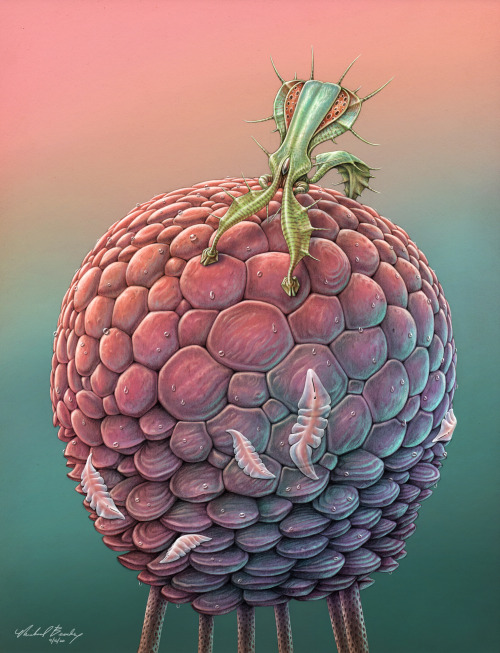
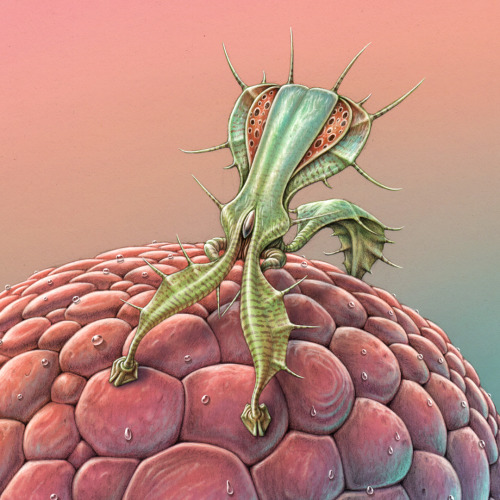
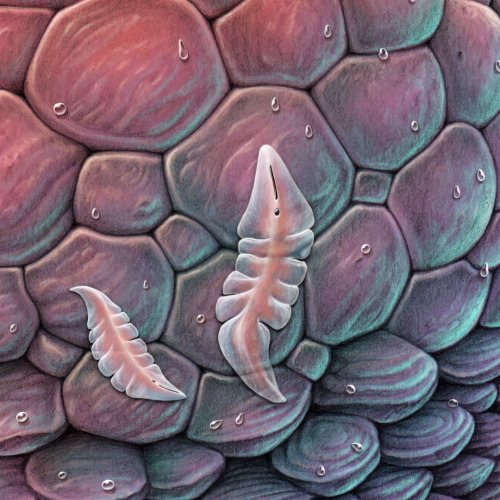
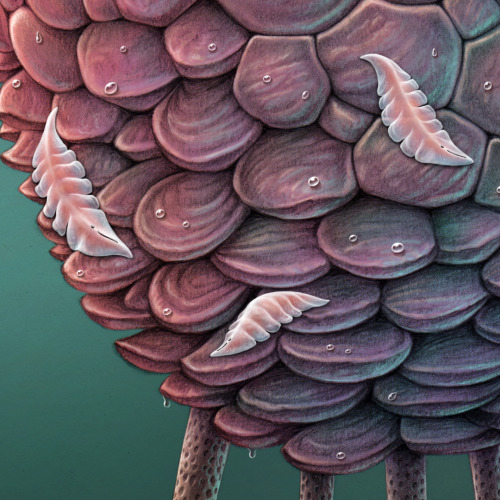
Guardian
On Veteris, it is common for creatures to obtain energy from multiple sources. The large round, multifaceted autotroph angles its plates to face the light at any given time of day. It also feeds on decomposing organic matter it obtains by moving slowly on its long spindly legs. Conversely, the spiny guardian on top originally evolved to hunt the semi-transparent flat creatures that feed on the autotroph, but came to rely on them exclusively. Over many generations, individuals that allowed some prey items to live and reproduce eventually outlasted the more aggressive hunters, and now their style of subsistence is closer to farming. The guardians now protect the entire micro-system – each large round walker and its flock of parasites is topped by a spiny guardian who has the dual task of defending against predators as well as keeping the herd numbers in check. A round walker without a guardian slowly succumbs to parasite overpopulation. Occasionally huge numbers of walkers congregate in vast gently-swaying miniature forests, each crowned by a flamboyant spiny guardian defending its small world.
You are one of my biggest inspirations for creature design. Your aliens are beautiful and unique, and when I look at your art it feels like I’m actually there! Your art is beautiful
Thank you so much! I’m honored to be an inspiration for you.
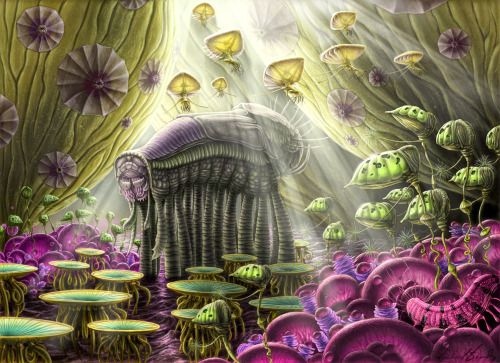
This is the native habitat of the megamyriapod (at center). This slow-moving, placid beast is about twenty feet tall and feeds primarily on the purple wave carpet organism that is spread across the floor of this scene- gathering it up with its anterior grasping appendages (at left). Other creatures lurk here, including the greenish motile floating feather duster gourds, the yellow/teal walking platter life-forms, and the purple pilantir balls. Growing around and above these smaller living things are the gargantuan lineated gold air-sponges - the megaflora that constitute the main physical features in this environment. All these creatures obtain energy from a combination of photosynthesis and physical consumption of soil nutrients or living tissue. Basically, the strict division of heterotroph/autotroph (plant/animal) that is exhibited by Earth-life simply does not apply here. Rather there is a gradient between those creatures who gain energy exclusively from light, and those who must consume others to survive. The majority of creatures here utilize both approaches.





Sunworshipper
By our terrestrial standards, the coloration on this creature may seem vivacious or even gaudy, but in its native habitat it actually serves as cryptic camouflage. Its planet orbits a star with different color output than our own, and photosynthetic systems have adapted to reflect a different color than our earthly green plants. The sunworshipper, like many other mobile creatures here, receives a portion of its energy from photosynthesis - as evidenced by the specially-adapted appendages radiating from its body.
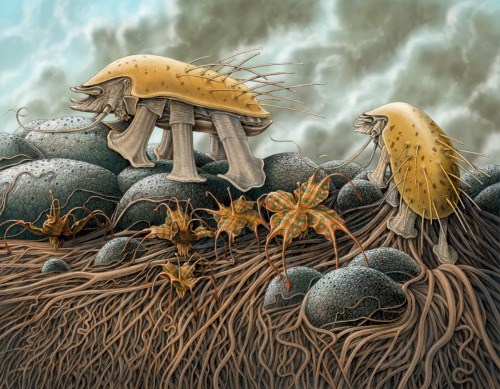
New Lands
-
 lemotjuste-tx reblogged this · 7 months ago
lemotjuste-tx reblogged this · 7 months ago -
 tv1977 liked this · 7 months ago
tv1977 liked this · 7 months ago -
 lorrekeeper liked this · 8 months ago
lorrekeeper liked this · 8 months ago -
 tundragravedigger reblogged this · 9 months ago
tundragravedigger reblogged this · 9 months ago -
 tundragravedigger liked this · 9 months ago
tundragravedigger liked this · 9 months ago -
 tilbugs liked this · 9 months ago
tilbugs liked this · 9 months ago -
 crimnsontroll liked this · 10 months ago
crimnsontroll liked this · 10 months ago -
 cunnnilinguist liked this · 10 months ago
cunnnilinguist liked this · 10 months ago -
 ara6gir liked this · 10 months ago
ara6gir liked this · 10 months ago -
 lamehandle liked this · 10 months ago
lamehandle liked this · 10 months ago -
 darwinthepaleonaturalist reblogged this · 1 year ago
darwinthepaleonaturalist reblogged this · 1 year ago -
 darwinthepaleonaturalist reblogged this · 1 year ago
darwinthepaleonaturalist reblogged this · 1 year ago -
 darwinthepaleonaturalist reblogged this · 1 year ago
darwinthepaleonaturalist reblogged this · 1 year ago -
 darwinthepaleonaturalist reblogged this · 1 year ago
darwinthepaleonaturalist reblogged this · 1 year ago -
 darwinthepaleonaturalist liked this · 1 year ago
darwinthepaleonaturalist liked this · 1 year ago -
 justgoji reblogged this · 1 year ago
justgoji reblogged this · 1 year ago -
 justgoji liked this · 1 year ago
justgoji liked this · 1 year ago -
 jayjayzzzzzz liked this · 1 year ago
jayjayzzzzzz liked this · 1 year ago -
 surrendertomywill reblogged this · 1 year ago
surrendertomywill reblogged this · 1 year ago -
 idontwannaliveinasociety liked this · 1 year ago
idontwannaliveinasociety liked this · 1 year ago -
 neddalian liked this · 1 year ago
neddalian liked this · 1 year ago -
 shrillestceiling liked this · 1 year ago
shrillestceiling liked this · 1 year ago -
 wurmwizzard liked this · 1 year ago
wurmwizzard liked this · 1 year ago -
 crepuscular-girlthing liked this · 1 year ago
crepuscular-girlthing liked this · 1 year ago -
 heywassap93 reblogged this · 1 year ago
heywassap93 reblogged this · 1 year ago -
 equibo liked this · 1 year ago
equibo liked this · 1 year ago -
 dopefishcollection liked this · 1 year ago
dopefishcollection liked this · 1 year ago -
 funlander51015 liked this · 1 year ago
funlander51015 liked this · 1 year ago -
 sixxer liked this · 1 year ago
sixxer liked this · 1 year ago -
 magnificentsweetsdaze reblogged this · 1 year ago
magnificentsweetsdaze reblogged this · 1 year ago -
 magnificentsweetsdaze liked this · 1 year ago
magnificentsweetsdaze liked this · 1 year ago -
 sweet-honey-flowers liked this · 1 year ago
sweet-honey-flowers liked this · 1 year ago -
 alienworlds reblogged this · 1 year ago
alienworlds reblogged this · 1 year ago -
 yenoodlethings liked this · 1 year ago
yenoodlethings liked this · 1 year ago -
 sanemeks liked this · 1 year ago
sanemeks liked this · 1 year ago -
 troythecatfish liked this · 1 year ago
troythecatfish liked this · 1 year ago -
 jankiwen liked this · 1 year ago
jankiwen liked this · 1 year ago -
 luxudus liked this · 1 year ago
luxudus liked this · 1 year ago -
 feromono liked this · 1 year ago
feromono liked this · 1 year ago -
 evolutionarilycognitivehat reblogged this · 2 years ago
evolutionarilycognitivehat reblogged this · 2 years ago -
 sunsetburn liked this · 2 years ago
sunsetburn liked this · 2 years ago -
 fortuitousrex liked this · 2 years ago
fortuitousrex liked this · 2 years ago -
 bluntfiend161 liked this · 2 years ago
bluntfiend161 liked this · 2 years ago -
 red-wood-system reblogged this · 2 years ago
red-wood-system reblogged this · 2 years ago -
 xonxoi-art liked this · 2 years ago
xonxoi-art liked this · 2 years ago -
 alienworlds reblogged this · 2 years ago
alienworlds reblogged this · 2 years ago -
 cb-reblog reblogged this · 2 years ago
cb-reblog reblogged this · 2 years ago -
 cb-reblog liked this · 2 years ago
cb-reblog liked this · 2 years ago